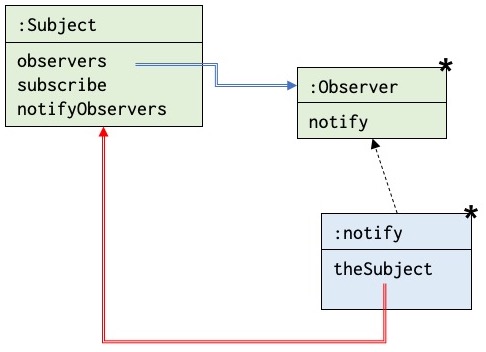In this section, we introduce two related aspects, subject and observer, which have to be used in tandem. Objects of classes with a subject aspect may be observed by a set of objects with an observer aspect. An observer object subscribes to certain events in the subject object, events that typically change the state of the subject object. In a case of such an event, the observer will be notified.
As a first example, we use a a fire alarm in a shopping center with a number of shops. The fire alarm may be considered a subject to be observed by a number of stakeholders that include the fire department, the owner of the shopping center and the shops in the center. As a second example, we show how to add subject and observer aspects to the bank system to monitor suspicious transactions on the accounts of the bank.
Måske en illustration der viser subject/alarm og observers/FireDept, …? Og som en almindelig illustration – ikke et objekt-diagram.
Before we show how to represent the examples, we introduce some general classes for representing subjects and observers represented by Subject and Observer. Objects being subject to observation shall have the properties of Subject, and observer objects shall have the properties of Observer. The structure and behaviour of class Observer and class Subject is known as the Observer Design Pattern – we thus place the two classes in a module called ObserverPattern:
ObserverPattern: obj
class Subject:
observers: obj Set(#Observer)
subscribe(obs: ref Observer):
observers.insert(obs)
notifyObservers:
observers.scan
current.notify(this(Subject))
inner(Subject)
class Observer:
class ObservedSubject:< Subject
notify(theSubject: ref ObservedSubject):<
inner(notify)- A
Subjecthave aSetobserverscontainingObserverobjects. - It has a method
subscribethat makes anObserverobject an element ofobservers; - It has a method
notifyObserversthat is called in case the observeres should be notified about changes, so it will for eachobserverinobserversinvoke itsnotify. - An
Observerhas a local virtual classObservedSubjectthat can be extended with further attributes in subclasses of the observedSubject. - It has a method
notify, which has a parameter,theSubjectof typeObservedSubject, which is a reference to theSubjectthat invokesnotify.
The figure below illustrates that a Subject has a set (observers) of references to a number of Observer objects; this is illustrated with the ‘*’ in rightmost top of the Observer object. The figure also illustrate that when notify is invoked on these Observer objects, the parameter theSubject of each notify method object is set to denote the Subject object that invoked notify:

The dashed line indicates that each notify method object is an instance of the method notify of a given Observer object.
The classes Subject and Observer are rather abstract so in the next section we will show how the above example of a fire alarm in a shopping center may be modeled using the ObserverPattern. We show how to add subject and observer aspects to the bank system in the section following the next section.
